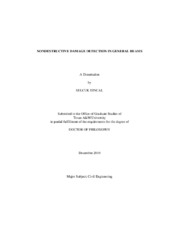| dc.description.abstract | Monitoring the integrity of civil engineering structures is an imperative aspect of public safety, since structural failures can pose serious threats to life and property. Periodic inspection performed throughout the life span of these structures is also vital for a nation’s economy. Substantial sums of money may be saved upon detecting structural deterioration in a timely manner.
Nondestructive damage evaluation (NDE) offers effective and economically feasible solutions to perform such tasks. Better predictions can be made regarding the current state of structures, and structurally deficient regions that need immediate attention may successfully be narrowed down by utilizing NDE. For these reasons, a considerable amount of research has been conducted in the field of NDE over the past few decades. As a result, many different methodologies are now available, and many new ones continue to emerge as the need for better evaluation techniques prevails.
Upon reviewing the NDE methodologies proposed to date, it may be concluded that theories based on the fundamental equations of mechanics and mathematics in conjunction with justifiable assumptions provided the best results compared to the algorithms developed pragmatically. The goal of this study is to provide NDE methodologies that simultaneously identify the location, the extent, and the severity of damage in general beams. By general beams, we mean beyond Euler-Bernoulli beams (i.e. slender beams) to deep beams and stubby beams whose response may be based on the Timoshenko beam theory, and the Theory of Elasticity.
After presenting the governing equations of equilibrium and stress-displacement relations of the fundamental beam theories including the Euler-Bernoulli Beam theory, the Timoshenko beam theory, and the beam theory based on linear Elasticity Theory, mathematical expressions which relate physical properties (e.g. stiffness) of the undamaged and damaged structure to measurable response quantities (e.g. displacement, strains, etc.) are developed.
We believe that these algorithms will lead to earlier and more accurate prediction of damage in critical structures. The findings of this work will also lead to a better understanding of the limitations of the currently proposed NDE techniques. In addition, it is anticipated that by incorporating the methodologies proposed in this study to the continuous health monitoring of structural systems could reduce the cost of maintenance and offer safer infrastructure networks. | en |


